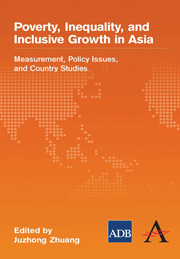Book contents
- Frontmatter
- Contents
- Foreword
- Preface and Acknowledgments
- Contributors
- Abbreviations, Acronyms, and Symbols
- Tables, Figures, and Boxes
- 1 Poverty, Inequality, and Inclusive Growth in Asia
- Part A Measuring Inequality and Poverty
- Part B Selected Policy Issues for Inclusive Growth
- Part C Country Studies
- Index
Foreword
Published online by Cambridge University Press: 05 March 2012
- Frontmatter
- Contents
- Foreword
- Preface and Acknowledgments
- Contributors
- Abbreviations, Acronyms, and Symbols
- Tables, Figures, and Boxes
- 1 Poverty, Inequality, and Inclusive Growth in Asia
- Part A Measuring Inequality and Poverty
- Part B Selected Policy Issues for Inclusive Growth
- Part C Country Studies
- Index
Summary
The single biggest policy challenge facing Asia is how to sustain rapid economic growth that reduces poverty and is socially inclusive and environmentally sustainable. The challenges–and opportunities–are all the greater given rapid population growth in much of the region, the need to rebalance growth in light of the global financial crisis, and the multiple challenges of responding to climate change. This timely book brings together some of the latest research and findings on poverty reduction, inequality, and conceptual and policy issues of inclusive growth in Asia.
The book highlights Asia's remarkable economic achievements. Between 1990 and 2008, the region's per capita gross domestic product (GDP) increased almost three-fold, expanding 5.7% a year. Growth was most pronounced in East Asia, at over 8% a year, driven largely by the People's Republic of China (PRC). It was also solid in many countries in Southeast Asia—where the shock of the 1997/98 financial crisis was particularly strong—and, more recently, in India. But per capita GDP growth was nowhere near as robust elsewhere. The economy of Central and West Asia grew just 1.3% annually over 1990–2008, and the Pacific only 0.3%.
In much of Asia, rapid growth has improved the livelihoods of vast numbers of people. The percentage of people living below the $1.25-a-day poverty line fell from 52.3% in 1990 to 27.1% in 2005. The poverty reduction was the largest in the PRC, where it fell from 60.2% in 1990 to 15.9% in 2005, but it was also significant in many other countries.
- Type
- Chapter
- Information
- Poverty, Inequality, and Inclusive Growth in AsiaMeasurement, Policy Issues, and Country Studies, pp. xi - xiiPublisher: Anthem PressPrint publication year: 2010

